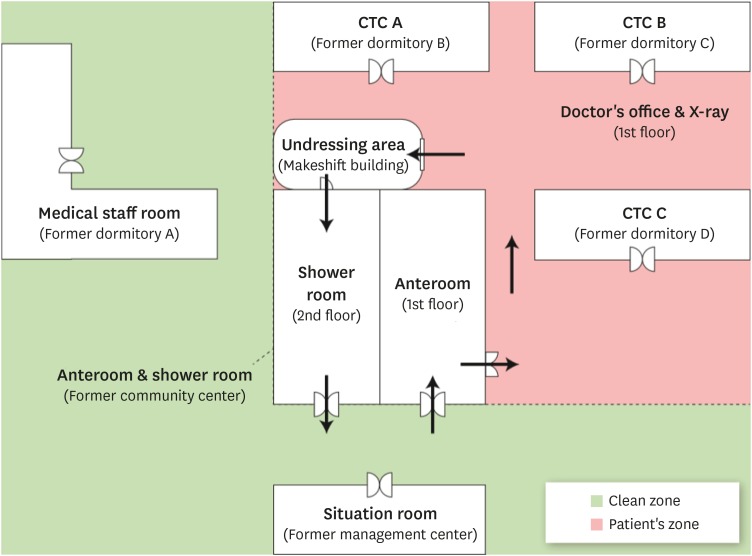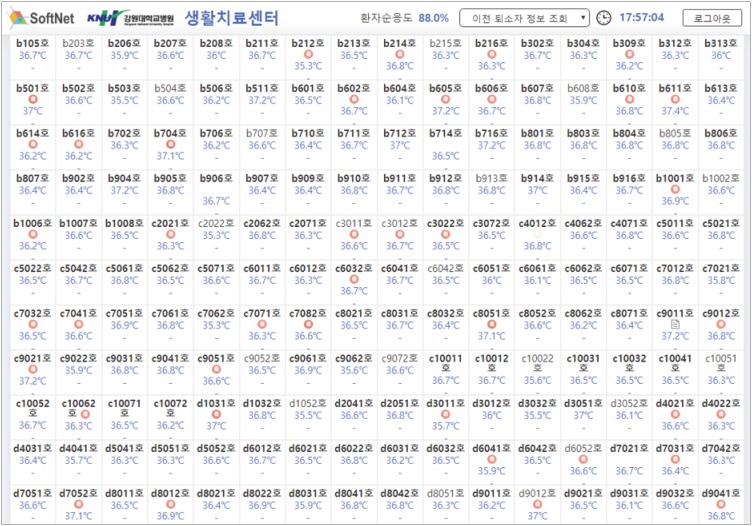Out-of-Hospital Cohort Treatment of Coronavirus Disease 2019 Patients with Mild Symptoms in Korea: an Experience from a Single Community Treatment Center
- Affiliations
-
- 1Ministry of Health and Welfare, Sejong, Korea.
- 2Department of Internal Medicine, Kangwon National University Hospital, Chuncheon, Korea.
- 3Department of Otorhinolaryngology, Kangwon National University Hospital, Chuncheon, Korea
- 4Department of Internal Medicine, Kangwon National University School of Medicine, Chuncheon, Korea.
- 5Department of Emergency Medicine, Kangwon National University School of Medicine, Chuncheon, Korea.
- 6Department of Neurosurgery, Kangwon National University School of Medicine, Chuncheon, Korea.
- KMID: 2509608
- DOI: http://doi.org/10.3346/jkms.2020.35.e140
Abstract
- The outbreak of Coronavirus Disease 2019 (COVID-19) caused a worldwide pandemic. Less than 6 weeks after the first confirmed cases in Korea, the patient number exceeded 5,000, which overcrowded limited hospital resources and forced confirmed patients to stay at home. To allocate medical resources efficiently, Korea implemented a novel institution for the purpose of treating patients with cohort isolation out of hospital, namely the Community Treatment Center (CTC). Herein, we report results of the initial management of patients at one of the largest CTC in Korea. A total of 309 patients were admitted to our CTC. During the first two weeks, 7 patients were transferred to the hospital because of symptom aggravation and 107 patients were discharged without any complication. Although it is a novel concept and may have some limitations, CTC may be a very cost-effective and resource-saving strategy in managing massive cases of COVID-19 or other emerging infectious diseases.
Figure
Cited by 4 articles
-
A Systematic Narrative Review of Comprehensive Preparedness Strategies of Healthcare Resources for a Large Resurgence of COVID-19 Nationally, with Local or Regional Epidemics: Present Era and Beyond
Young Kyung Yoon, Jacob Lee, Sang Il Kim, Kyong Ran Peck
J Korean Med Sci. 2020;35(44):e387. doi: 10.3346/jkms.2020.35.e387.Quarantine Facility for Patients with COVID-19 with Mild Symptoms in Korea: Experience from Eighteen Residential Treatment Centers
Yuseon Yang, Hyejung Kim, Jieun Hwang
J Korean Med Sci. 2020;35(49):e429. doi: 10.3346/jkms.2020.35.e429.The Psychological Burden of COVID-19 Stigma: Evaluation of the Mental Health of Isolated Mild Condition COVID-19 Patients
EunKyo Kang, Sun Young Lee, Min Sun Kim, Hyemin Jung, Kyae Hyung Kim, Kyoung-Nam Kim, Hye Yoon Park, Yu Jin Lee, Belong Cho, Jee Hoon Sohn
J Korean Med Sci. 2021;36(3):e33. doi: 10.3346/jkms.2021.36.e33.Analyses of Confirmed COVID-19 Cases Among Korean Military Personnel After Mass Vaccination
Dong Hoon Shin, Hong Sang Oh, Haebong Jang, Sangho Lee, Byung Seop Choi, Donghoon Kim
J Korean Med Sci. 2022;37(3):e23. doi: 10.3346/jkms.2022.37.e23.
Reference
-
1. World Health Organization. Coronavirus disease 2019 (COVID-19) Situation Report??3. Updated 2020. Accessed March 18, 2020. https://www.who.int/docs/default-source/coronaviruse/situation-reports/20200313-sitrep-53-covid-19.pdf.2. Kim KH, Tandi TE, Choi JW, Moon JM, Kim MS. Middle East respiratory syndrome coronavirus (MERS-CoV) outbreak in South Korea, 2015: epidemiology, characteristics and public health implications. J Hosp Infect. 2017; 95(2):207–213. PMID: 28153558.
Article3. Korea Centers for Disease Control and Prevention. The updates of COVID-19 in the Republic of Korea. Updated 2020. Accessed March 18, 2020. https://www.cdc.go.kr/board/board.es?mid=a20501000000&bid=0015.4. Korean Society of Infectious Diseases. Korean Society of Pediatric Infectious Diseases; Korean Society of Epidemiology; Korean Society for Antimicrobial Therapy; Korean Society for Healthcare-associated Infection Control and Prevention; Korea Centers for Disease Control and Prevention. Report on the epidemiological features of coronavirus disease 2019 (COVID-19) outbreak in the Republic of Korea from January 19 to March 2, 2020. J Korean Med Sci. 2020; 35(10):e112. PMID: 32174069.5. World Health Organization. Rational use of personal protective equipment for coronavirus disease 2019 (COVID-19). Interim guidance 27 February 2020. Updated 2020. Accessed March 18, 2020. https://www.who.int/iris/bitstream/handle/10665/331215/WHO-2019-nCov-IPCPPE_use-2020.1-eng.pdf.6. World Health Organization. Laboratory testing for 2019 novel coronavirus (2019-nCoV) in suspected human cases. Updated 2020. Accessed March 18, 2020. https://www.who.int/publications-detail/laboratory-testing-for-2019-novel-coronavirus-in-suspected-human-cases-20200117.7. Korea Centers for Disease Control and Prevention. Guideline for management of COVID-19. Updated 2020. Accessed March 23, 2020. http://www.cdc.go.kr/board.es?mid=a20507020000&bid=0019&act=view&list_no=366558.8. Corman VM, Landt O, Kaiser M, Molenkamp R, Meijer A, Chu DK, et al. Detection of 2019 novel coronavirus (2019-nCoV) by real-time RT-PCR. Euro Surveill. 2020; 25(3):2000045.
Article
- Full Text Links
- Actions
-
Cited
- CITED
-
- Close
- Share
- Similar articles
-
- Four cases of coronavirus disease 2019 in the early stage of pandemic of South Korea: a single public hospital experience
- How We Have Treated Severe to Critically Ill Patients With Coronavirus Disease 2019 in Korea
- Quarantine Facility for Patients with COVID-19 with Mild Symptoms in Korea: Experience from Eighteen Residential Treatment Centers
- Long COVID-19 and Health-Related Quality of Life of Mild Cases in Korea: 3-Months Follow-up of a Single Community Treatment Center
- Real World Experience with Regdanvimab Treatment of Mild-toModerate Coronavirus Disease-19 in a COVID-19 Designated Hospital of Korea



